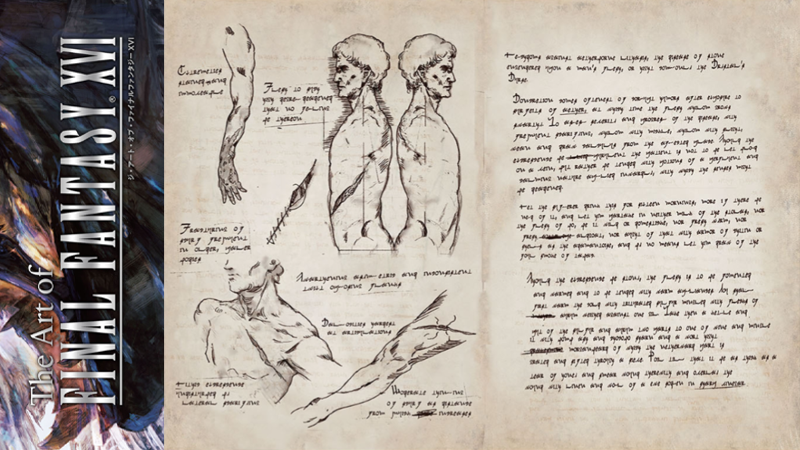A round-up of the Valisthean text that appears in The Art of Final Fantasy XVI. All appear in-game, but some I wasn’t able to make out until I read them here. I did this for my own amusement, but I’m sharing it in case anyone else is curious :)
Maps
This isn’t an exhaustive list-up of all the maps that appear in The Art of Final Fantasy XVI, just the ones featuring text that hasn’t been elucidated by some other means (e.g. the in-game dialogue and field maps).
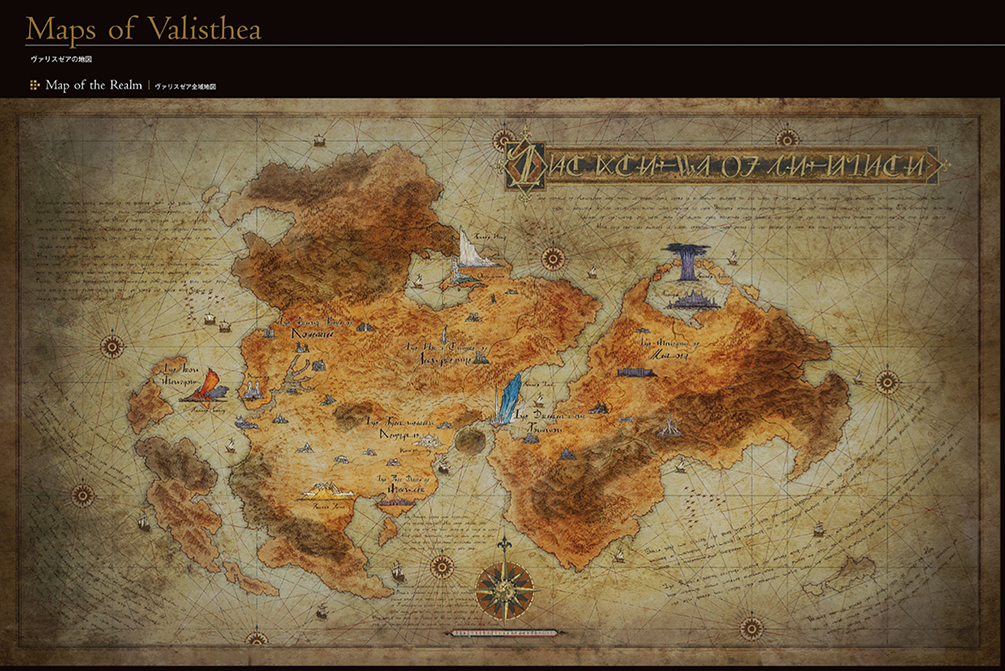
The Map of the Realm (unsurprisingly) reads: THE REALMS OF VALISTHEA.
n.b. I’m not going to share any Valisthean text I haven’t deciphered myself, but if you’re curious what the minute text on this map says, 限界トルガルさん (@musebigenkai) on Xitter posted a thread with the text in English and Japanese. If you want to know anything about anything in Valisthean, he’s your guy.

These travelers’ maps are the two that appear on Vivian’s wall in the new hideaway. The top one is also the map on Clive’s desk, while the bottom one is also the map on Cid’s desk in Y.R. 873 and the map the Cursebreakers and Gav reference in Y.R. 878. Their titles read:
- Valisthea as Composed of the Continents of Storm and Ash and Lands Adjacent (top/left)
- HOLY ORIFLAMME AND HER MOST BENEVOLENT SUBJECTS (bottom/right)
The other things labelled on them are the same as those on the in-game field maps (Oriflamme, etc.).
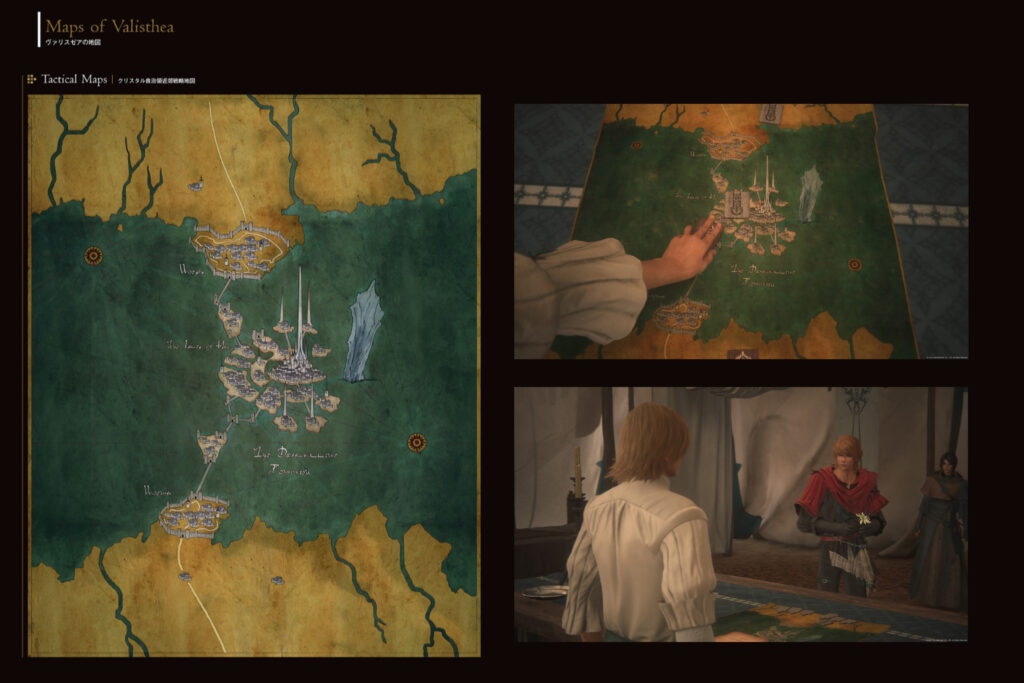
This tactical map is the one Dion is examining in the cutscene at the end of CH34 when Joshua and Jote make a surprise appearance in his field command tent.
The names ‘The Crystalline Dominion’ and ‘The Isles of Ark’ will be familiar to anyone who’s played the game, but this map also labels Noesis (the part of the Dominion situated on Storm) and Noema (the part of it situated on Ash).
Written Word
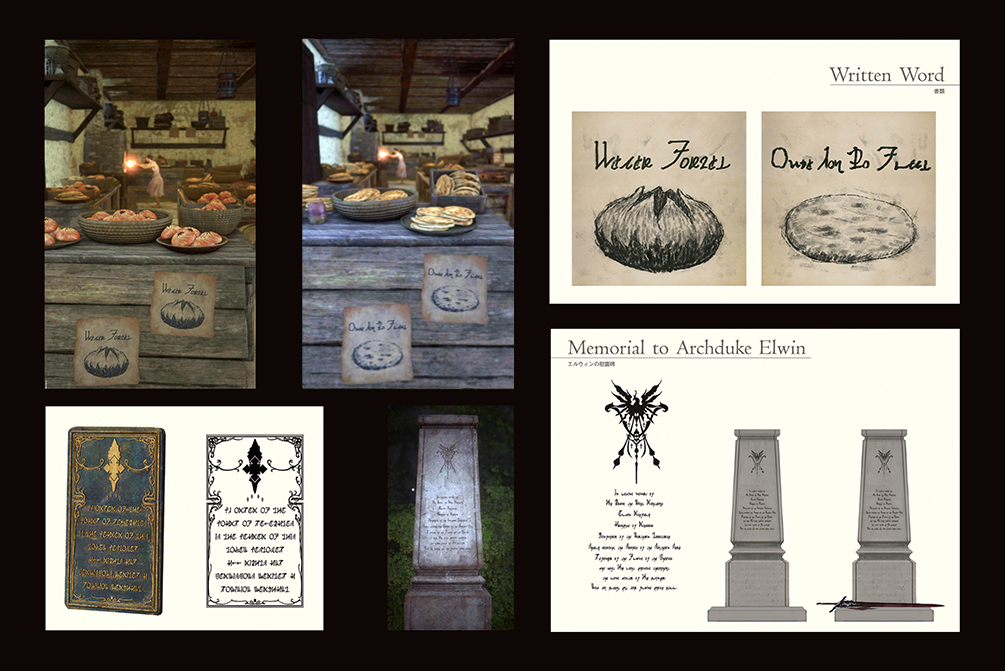
You can read these signs in Dalimil by ‘inspecting’ them in the game, but for what it’s worth, they read: Once You Go Flat (right) & Never Forget (left). The sign changes over after SQ40 ‘Use Your Loaf’ in CH35. The fliers also appear in the Tub & Crown at the hideaway after you talk to Miruna.
The text on Goetz’s trader’s pass (bottom left) is as it appears in the item description. You can also read the Valisthean text on the passes themselves if you go over and look at them after completing Q50 ‘Blood from the Stones’ in CH36 (they’re amongst the stolen items Theodore has to sort through).
BY ORDER OF THE
BOARD OF DELEGATES
IS THE BEARER OF THIS
TOKEN BESTOWED
ALL RIGHTS AND
PERMISSIONS MERITED A
DOMINION MERCHANT
The text on Archduke Elwin’s Cenotaph (bottom right) reads:
In loving memory of
His Grace the Most Righteous
Elwin Rosfield
Archduke of Rosaria
Conqueror of the Northern Territories
Shield against the Scourge of the Southern Seas
Defender of the Flame of the Phoenix
who kept His light burning throughout
the long winter of His slumber
Now you sleep, but your flame burns still
n.b. The sword lying across the memorial’s base is Elwin’s sword, depicted elsewhere in the Art Book.
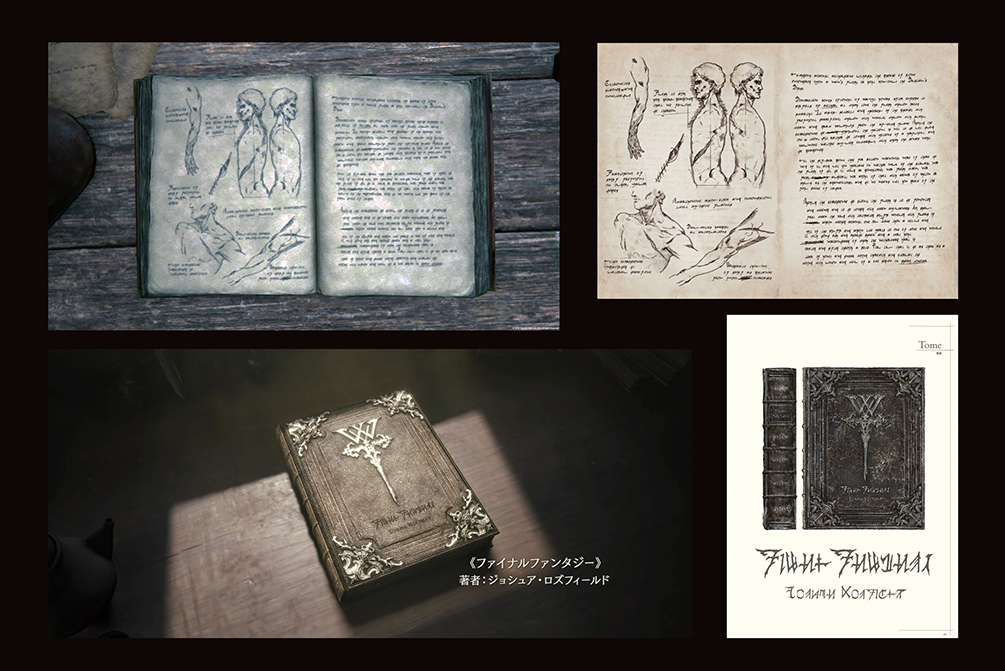
The upper spread is from Tarja’s tome on aetherborne lithiasis, a.k.a. the crystals’ curse. It reads as follows (all spellings and punctuation have been preserved):
[Left page]- Extremities stained and immoveable
- Flesh to such high degree deadened that no feeling be thereon
- Fracturing of scurf frequent in older, paler bodies
- Swarthening asymmetric and inconsistent twixt opposing flanks
- Callocities hardest at articulations
- Lithic excrescence undisturbed by lateral scarifying
- Moderate thinning of scurf as distance from quick [scratched out] increases
Note:
*scurf = the scales or small shreds of epidermis that are continually exfoliated from the skin
*callocities = calluses
*scarify = to make scratches or superficial incisions in the skin to produce an immune response or administer certain injections
Leechdoms against aetherborne lithasis, the disease of stone engendered upon a man’s flesh, or hight commonly the Crystals’ Curse.
Concretion comes oftenest of corrupt humors after exposure to surfeits of aether, at which time the flesh whilom grows swarthy. To assess severity and progress of the disease, with frequent scarifying, whilom with mickle, whilom with slight, wean and draw calculus from the affected place. Should the excrescence be [scratched out] purulent, the patient is not to be let blood on a vein, but rather be tended with potions of a perfluent and calming nature applied inwardly, with which senses might be deadened.
Let the sufferer drink this for sixteen mornings, more if there be need of it, and let him partake in neither milk of the stolas, nor the flesh of bo, be it wild or domesticke, nor fresh wyrm, nor fresh [scratched out] aldgoat, nor aught of that with armor of chitin or shells as the adamantoise, and by no means let him draw of the foul smoke of tabac.
Should the excrescence be stony, the flesh is to be fomented and warmed and to be tended with warm appliances. You shall first warm the cold with triturated sulfur mingled with flecks of [scratched out] aurum weighed against one gil. Take then a kettle and put of the sulfur and aurum two parts to one and mingle with bomb ash and chocobo sharn and a wort hight [scratched out] morganbeard of which the netherward part is grated and sifted through a sieve. Boil till that it be as thick as a tear of honey and smear wound therewith and overlay the wound with linen and wool of a ewe sodden in sharp vinegar.
Notes:
*leechdoms = treatments
*hight = (archaic) called or named
*humors = (in medieval physiology) the four elemental fluids of the body: blood, phlegm, black bile, and yellow bile
*whilom = at one time, at times ~; former, erstwhile; formerly, once
*mickle = (archaic) great, large [in amount]
*calculus = (pathology) a stone, or concretion, formed in the gallbladder, kidneys, or other parts of the body
*perfluent = flowing/passing through
*bo = chocobo
*tabac = tabacco in FFXVI
*foment = to apply warm water or medicated liquid, etc. to [the surface of the body]
*triturate = to reduce to fine particles or powder
*sharn = (archaic/dialect) manure or dung
*aurum = gold
*wort = (also sometimes wyrt) a plant, herb, or vegetable
n.b. As anyone who’s ever read Chaucer or Sir Gawain and the Green Knight will know, English spellings weren’t standardised until long after the Middle Ages, so the texts that appear in FFXVI contain all sorts of spelling variants. English speakers will probably recognise the words, regardless, but for what it’s worth:
*domesticke = domestic
*aldgoat = aldergoat, elder goat, old goat
The second tome, of course, needs no translation:
FINAL FANTASY
JOSHUA ROSFIELD
All source materials belong to the parties to which they are licensed. All translations are our own.

